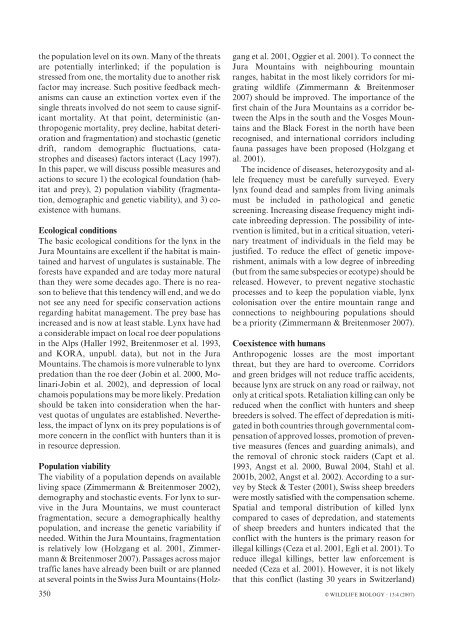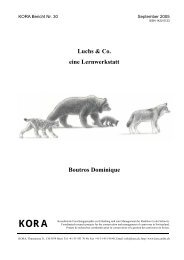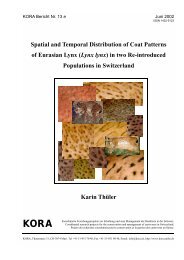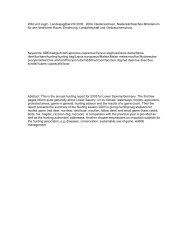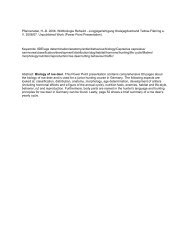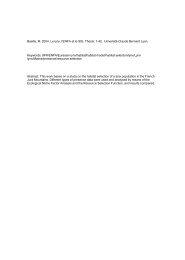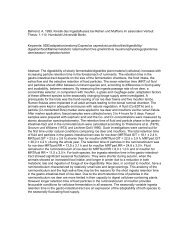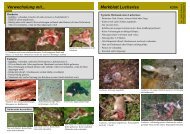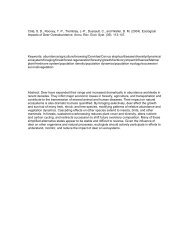Breitenmoser, U., Breitenmoser-Würsten, Ch., Capt, S ... - Kora
Breitenmoser, U., Breitenmoser-Würsten, Ch., Capt, S ... - Kora
Breitenmoser, U., Breitenmoser-Würsten, Ch., Capt, S ... - Kora
Create successful ePaper yourself
Turn your PDF publications into a flip-book with our unique Google optimized e-Paper software.
the population level on its own. Many of the threats<br />
are potentially interlinked; if the population is<br />
stressed from one, the mortality due to another risk<br />
factor may increase. Such positive feedback mechanisms<br />
can cause an extinction vortex even if the<br />
single threats involved do not seem to cause significant<br />
mortality. At that point, deterministic (anthropogenic<br />
mortality, prey decline, habitat deterioration<br />
and fragmentation) and stochastic (genetic<br />
drift, random demographic fluctuations, catastrophes<br />
and diseases) factors interact (Lacy 1997).<br />
In this paper, we will discuss possible measures and<br />
actions to secure 1) the ecological foundation (habitat<br />
and prey), 2) population viability (fragmentation,<br />
demographic and genetic viability), and 3) coexistence<br />
with humans.<br />
Ecological conditions<br />
The basic ecological conditions for the lynx in the<br />
Jura Mountains are excellent if the habitat is maintained<br />
and harvest of ungulates is sustainable. The<br />
forests have expanded and are today more natural<br />
than they were some decades ago. There is no reason<br />
to believe that this tendency will end, and we do<br />
not see any need for specific conservation actions<br />
regarding habitat management. The prey base has<br />
increased and is now at least stable. Lynx have had<br />
a considerable impact on local roe deer populations<br />
in the Alps (Haller 1992, <strong>Breitenmoser</strong> et al. 1993,<br />
and KORA, unpubl. data), but not in the Jura<br />
Mountains. The chamois is more vulnerable to lynx<br />
predation than the roe deer (Jobin et al. 2000, Molinari-Jobin<br />
et al. 2002), and depression of local<br />
chamois populations may be more likely. Predation<br />
should be taken into consideration when the harvest<br />
quotas of ungulates are established. Nevertheless,<br />
the impact of lynx on its prey populations is of<br />
more concern in the conflict with hunters than it is<br />
in resource depression.<br />
Population viability<br />
The viability of a population depends on available<br />
living space (Zimmermann & <strong>Breitenmoser</strong> 2002),<br />
demography and stochastic events. For lynx to survive<br />
in the Jura Mountains, we must counteract<br />
fragmentation, secure a demographically healthy<br />
population, and increase the genetic variability if<br />
needed. Within the Jura Mountains, fragmentation<br />
is relatively low (Holzgang et al. 2001, Zimmermann<br />
& <strong>Breitenmoser</strong> 2007). Passages across major<br />
traffic lanes have already been built or are planned<br />
at several points in the Swiss Jura Mountains (Holzgang<br />
et al. 2001, Oggier et al. 2001). To connect the<br />
Jura Mountains with neighbouring mountain<br />
ranges, habitat in the most likely corridors for migrating<br />
wildlife (Zimmermann & <strong>Breitenmoser</strong><br />
2007) should be improved. The importance of the<br />
first chain of the Jura Mountains as a corridor between<br />
the Alps in the south and the Vosges Mountains<br />
and the Black Forest in the north have been<br />
recognised, and international corridors including<br />
fauna passages have been proposed (Holzgang et<br />
al. 2001).<br />
The incidence of diseases, heterozygosity and allele<br />
frequency must be carefully surveyed. Every<br />
lynx found dead and samples from living animals<br />
must be included in pathological and genetic<br />
screening. Increasing disease frequency might indicate<br />
inbreeding depression. The possibility of intervention<br />
is limited, but in a critical situation, veterinary<br />
treatment of individuals in the field may be<br />
justified. To reduce the effect of genetic impoverishment,<br />
animals with a low degree of inbreeding<br />
(but from the same subspecies or ecotype) should be<br />
released. However, to prevent negative stochastic<br />
processes and to keep the population viable, lynx<br />
colonisation over the entire mountain range and<br />
connections to neighbouring populations should<br />
be a priority (Zimmermann & <strong>Breitenmoser</strong> 2007).<br />
Coexistence with humans<br />
Anthropogenic losses are the most important<br />
threat, but they are hard to overcome. Corridors<br />
and green bridges will not reduce traffic accidents,<br />
because lynx are struck on any road or railway, not<br />
only at critical spots. Retaliation killing can only be<br />
reduced when the conflict with hunters and sheep<br />
breeders is solved. The effect of depredation is mitigated<br />
in both countries through governmental compensation<br />
of approved losses, promotion of preventive<br />
measures (fences and guarding animals), and<br />
the removal of chronic stock raiders (<strong>Capt</strong> et al.<br />
1993, Angst et al. 2000, Buwal 2004, Stahl et al.<br />
2001b, 2002, Angst et al. 2002). According to a survey<br />
by Steck & Tester (2001), Swiss sheep breeders<br />
were mostly satisfied with the compensation scheme.<br />
Spatial and temporal distribution of killed lynx<br />
compared to cases of depredation, and statements<br />
of sheep breeders and hunters indicated that the<br />
conflict with the hunters is the primary reason for<br />
illegal killings (Ceza et al. 2001, Egli et al. 2001). To<br />
reduce illegal killings, better law enforcement is<br />
needed (Ceza et al. 2001). However, it is not likely<br />
that this conflict (lasting 30 years in Switzerland)<br />
350 E WILDLIFE BIOLOGY ? 13:4 (2007)


